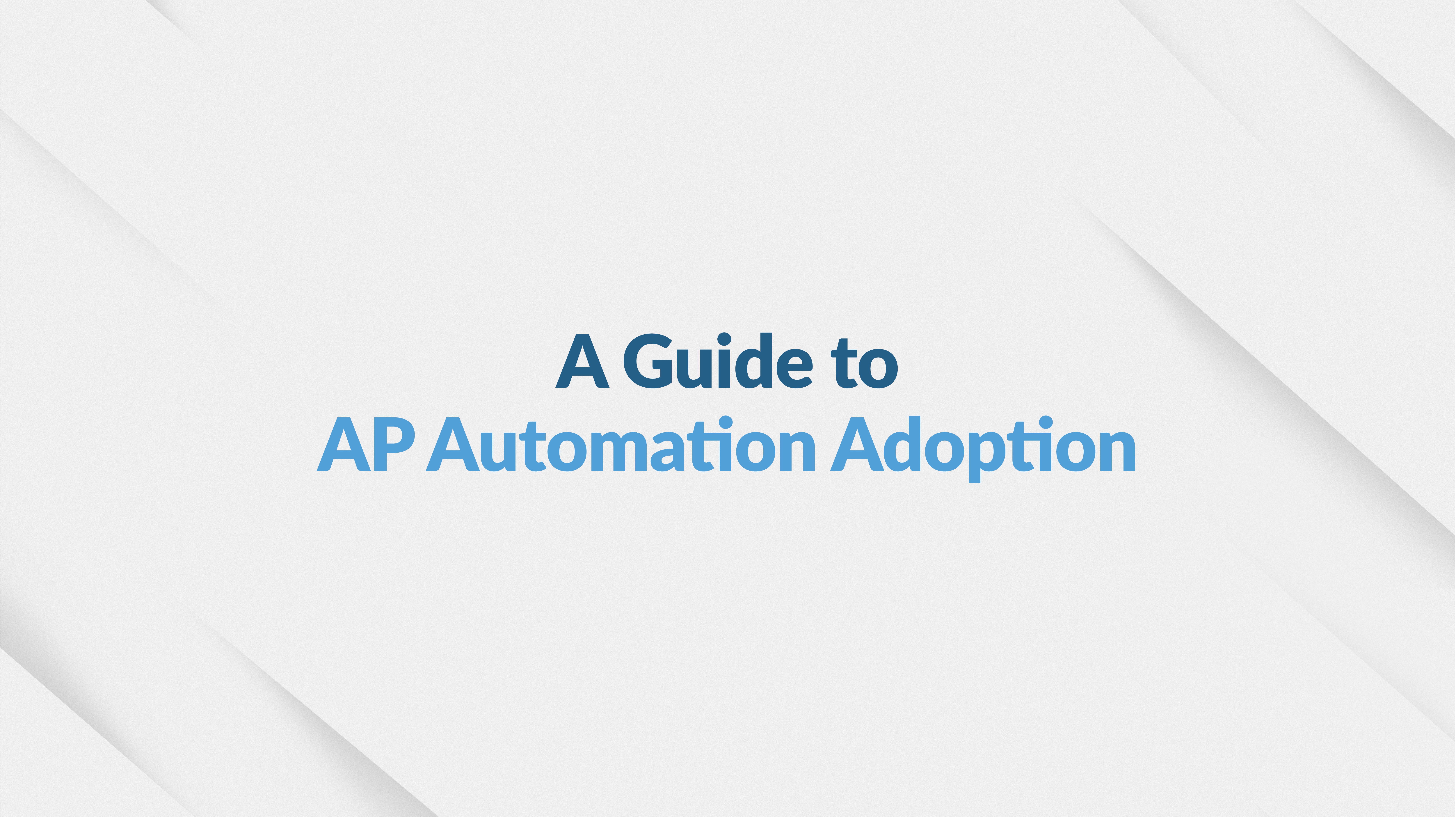Automated Accounts Receivable Programs: Cutting DSO by 30% in Six Months
In today’s economy, speed to cash is as important as speed to market. Companies that let receivables linger for 60, 75, or even 90 days are putting...

If you're still processing paper invoices in your accounts payable (AP) department, you’re not alone: At least 81.5% of accounting teams were still relying on varying degrees of manual invoice data entry in 2023 according to a survey by MineralTree.
But why was this percentage so high? The survey found that the majority of finance leaders surveyed believed that their current manual practices were working sufficiently. Others haven’t made the changeover to automated processes because of limited technical resources, lack of ERP integration, strained budgets, lack of business case and ROI–and last but not least–absence of executive sponsorship.
Regardless of percentages, many finance leaders are looking to adopt AP automation in the near future, as they are finding the cost savings, accuracy, and fraud detection capabilities of this technology is proving itself highly valuable.
This article will outline the many issues with manual invoice processing today and then walk you through the features and benefits of end-to-end AP automation.
Manual accounts payable processes are fraught with inefficiencies and risks that can lead to significant problems for an AP department, and the first thing that comes to mind for most AP professionals is the degree of time and labor it takes to process invoices.
Manual data entry into accounting systems is extremely time-consuming since each invoice must be reviewed, entered, and verified. This drains valuable employee time that could be better spent on strategic tasks. Additionally, routing invoices for approval can be slow and cumbersome, especially if done via physical documents or emails. This leads to bottlenecks, delaying the payment cycle.
Besides being time-consuming, manual AP processes are susceptible to errors such as incorrect data entry, misfiled paperwork, and missed deadlines. Errors in data entry can lead to discrepancies that require additional time and effort to resolve. Lost or misplaced documents add an additional layer to this problem, making it difficult to track and reconcile transactions.
If you’re still managing large volumes of paper invoices and supporting documents, then you’re well aware that you’ve got limited real-time visibility into the status of invoices and payments. This lack of transparency makes it difficult for management to make informed financial decisions and prepare thoroughly for audits.
Another problem reported often by financial leaders is the financial risk involved with manual AP processes. Delays in processing invoices can lead to late payments, resulting in penalties and strained vendor relationships. And without automated controls, manual processes are more vulnerable to fraud. There is a higher risk of duplicate payments, unauthorized transactions, and other fraudulent activities.
The final problem with manual invoice processing has to do with scalability, and more than anything else, this can be the most damaging. As a company grows, the volume of invoices increases. Scaling manual processes requires proportional increases in manpower, which is neither cost-effective nor sustainable. Not to mention, manual processes can create operational inefficiencies that impede an organization’s ability to scale effectively, affecting overall productivity and profitability.
Accounts payable (AP) automation refers to the use of technology to streamline and optimize the process of managing a company's payable accounts. It involves employing software solutions to handle tasks such as data entry, invoice processing, and payment scheduling, thereby reducing the time, cost, and error associated with traditional, manual AP processes.
A good AP automation solution will streamline every step of the AP process, from invoice receipt to vendor payment and records archival. Here’s what it can do:
Invoice Capture and Processing: AP automation software uses technologies like Optical Character Recognition (OCR) to digitize and extract data from paper or electronic invoices automatically. This reduces manual data entry and minimizes errors.
Workflow Automation: Automated workflows route invoices through the appropriate approval channels based on predefined rules. This ensures that invoices are reviewed, approved, or flagged for discrepancies in a consistent manner.
Integration with ERP Systems: AP automation tools often integrate seamlessly with Enterprise Resource Planning (ERP) systems, allowing for real-time updating of financial data and improved financial reporting.
vendor Management: The software can manage vendor information, track payment schedules, and even handle communication with vendors, ensuring timely payments and better vendor relationships.
Fraud Detection and Compliance: Automation tools include features to detect unusual activities and enforce compliance with company policies and regulations, helping to prevent fraud.
Some AP automation solutions are able to automate up to 100% of invoice processing, and you are likely to discover these benefits shortly after implementation:
Accounts payable (AP) automation is beneficial for businesses of all sizes, but it especially adds value to medium and large enterprises. These organizations typically handle high volumes of invoices and payments, making manual processes inefficient and error-prone. Automation streamlines these tasks, reduces labor costs, and improves accuracy, offering significant ROI.
Small businesses can also benefit from AP automation if they are experiencing growth or anticipate increased transaction volumes. Automation enhances efficiency, allowing small teams to manage more work without additional hires. Additionally, startups aiming for scalability and operational efficiency might find AP automation crucial for establishing streamlined processes early on.
In summary, while medium and large enterprises see immediate and substantial benefits from AP automation due to their high transaction volumes, small businesses and growing startups also stand to gain by improving efficiency, accuracy, and scalability in their financial operations.
The automation technology available today represents different aspects of the AP process, from invoice capture and approval workflows to payment processing and vendor management. By leveraging these technologies, your organization can significantly improve efficiency, accuracy, visibility, and control in the AP department.
A breakdown of the the elements follow:
This front-end automation function begins with Optical Character Recognition (OCR), a technology that digitizes paper invoices by scanning them and extracting relevant data. It reduces manual data entry, minimizes errors, and speeds up the invoicing process.
Electronic Data Interchange (EDI) is another function which allows for the direct exchange of invoices and other business documents between systems in a standardized electronic format. This eliminates the need for manual data entry and ensures data consistency.
Some automation solutions can process invoices received via email through email parsing, a process that extracts data from the email body or attachment and further reduces manual intervention.
Automated workflows route invoices to the appropriate approvers based on predefined rules and criteria. These workflows can include multiple stages of approval and exception handling, ensuring that invoices are reviewed and approved in a timely and consistent manner.
Additionally, two-way and three-way matching involve comparing the invoice, purchase order (PO), and receiving reports to ensure consistency. Automation can handle these matching processes, flagging any discrepancies for manual review and greatly reducing the time and effort required for manual matching.
This function allows vendors to submit invoices electronically, track payment statuses, and update their information. vendor portals improve communication and reduce the administrative burden on both the AP department and vendors.
Vendor Master Data Management: Automated systems can manage vendor information, ensuring that vendor data is accurate, up-to-date, and compliant with company policies and regulations. This reduces the risk of errors and fraud in the AP process.
Automated payment solutions schedule and process payments based on predefined rules, ensuring timely payments to vendors. These systems can handle various payment methods, including ACH, wire transfers, and checks.
Some solutions also offer virtual credit cards for vendor payments. These cards provide an additional layer of security and control, reducing the risk of fraud and streamlining the payment process.
Many automated AP solutions often include dashboards that provide real-time visibility into the status of invoices, payments, and overall AP performance. These dashboards help AP managers make informed decisions and identify areas for improvement.
Some advanced systems use predictive analytics to forecast cash flow needs, identify potential bottlenecks, and optimize the AP process. This proactive approach enhances financial planning and control.
AP automation tools typically integrate with Enterprise Resource Planning (ERP) systems, ensuring that data flows seamlessly between systems. This integration improves data accuracy, reduces manual entry, and enhances financial reporting. In addition to standard ERP integrations, some AP automation solutions offer custom integrations with other business systems, such as procurement and inventory management, providing a comprehensive view of the entire procure-to-pay process.
Choosing the right AP automation provider is a crucial decision that can significantly impact your organization's efficiency, accuracy, and financial control. Take these steps to help you make an informed choice:
Before you start evaluating providers, clearly define your business requirements and objectives by considering the following:
Conduct thorough research to identify potential AP automation providers. Consider factors like industry expertise, customer reviews, and corporate reputation.
Assess the features and functionalities of the shortlisted solutions. Key features include:
Request product demos and, if possible, trial periods for the shortlisted solutions. During this phase, assess the ease of user experience and gather an understanding of how the interface works. Review the level of customization available and evaluate the automation provider’s customer support and training resources.
Analyze the total cost of ownership, including:
Ensure the provider complies with relevant security standards and regulations. Key considerations include
Request references from the provider and speak to existing customers. Ask about their experiences, challenges, and overall satisfaction. This feedback can provide valuable insights into the provider's reliability and performance.
After thorough evaluation, compare the shortlisted providers based on your defined criteria. Consider conducting a cost-benefit analysis to weigh the potential ROI against the costs.
Once you’ve chosen a provider, finalize the agreement, clearly outlining the scope, deliverables, timeline, and pricing. Ensure all parties understand their responsibilities and expectations.
Automation Next Steps
Choosing an accounts payable automation provider is going to be a process defined largely by your automation requirements, budget, and business objectives. Whether you’re looking to simply automate your invoicing process or you’d like to find an end-to-end solution able to manage invoices from receipt to payment, CloudX can assist you in exploring your options.
For more information about CloudX’s APSmart solution, pleasefill out our online form here or call 860-787-5323 for a no-obligation consultation.

In today’s economy, speed to cash is as important as speed to market. Companies that let receivables linger for 60, 75, or even 90 days are putting...

Managing operational costs today often means balancing operational costs against tight margins, making it essential to join a group purchasing...